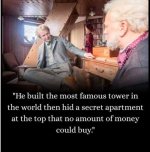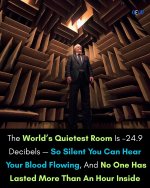-
Please be sure to read the rules and adhere to them. Some banned members have complained that they are not spammers. But they spammed us. Some even tried to redirect our members to other forums. Duh. Be smart. Read the rules and adhere to them and we will all get along just fine. Cheers. :beer: Link to the rules: https://www.forumsforums.com/threads/forum-rules-info.2974/
You are using an out of date browser. It may not display this or other websites correctly.
You should upgrade or use an alternative browser.
You should upgrade or use an alternative browser.
Did You Know ...
- Thread starter Doc
- Start date
but also the typical female.So pretty much a typical man.
On July 17, 1955, Las Vegas woke before dawn. The neon signs still glowed faintly as the desert sky began to pale. At the Desert Inn pool, the air smelled of chlorine and coffee. A handful of early swimmers balanced on diving boards, chatting lazily. Then, at precisely 5:30 a.m., the horizon erupted.
A white flash split the desert sky — and seconds later, a giant mushroom cloud began to climb, a ghostly pillar of fire and ash visible from sixty-five miles away. It was Operation Teapot, one of the Nevada Test Site’s many nuclear detonations.
Instead of panic, applause. Tourists sipped cocktails, children floated on pool rings, and couples leaned over balcony rails to watch the atomic dawn. The explosion had become a form of entertainment — a symbol of America’s unshakable confidence in its own power.
In that eerie stillness, Las Vegas embodied the contradictions of the Atomic Age: optimism mingled with oblivion, spectacle masking peril. The city sold postcards of mushroom clouds and “atomic breakfast” specials at the Sands Hotel. Beneath the glamour, a silent rain of fallout drifted eastward.
That morning, for a brief and blinding moment, leisure and annihilation shared the same horizon.

A white flash split the desert sky — and seconds later, a giant mushroom cloud began to climb, a ghostly pillar of fire and ash visible from sixty-five miles away. It was Operation Teapot, one of the Nevada Test Site’s many nuclear detonations.
Instead of panic, applause. Tourists sipped cocktails, children floated on pool rings, and couples leaned over balcony rails to watch the atomic dawn. The explosion had become a form of entertainment — a symbol of America’s unshakable confidence in its own power.
In that eerie stillness, Las Vegas embodied the contradictions of the Atomic Age: optimism mingled with oblivion, spectacle masking peril. The city sold postcards of mushroom clouds and “atomic breakfast” specials at the Sands Hotel. Beneath the glamour, a silent rain of fallout drifted eastward.
That morning, for a brief and blinding moment, leisure and annihilation shared the same horizon.

Discipline will conquer that flaw.Did you know emotions determine what you think you know and emotions rule the mind. We are rational or logical primarily. Emotions determine how intelligence is applied. The Limbic system is more powerful than the prefrontal cortex
We are all steered by our emotions. We do not have to be.
Only a self-discipline, AKA SPOCK LOGIC, will keep our decisions safely within reason.
Sigma's have this advantage.
Last edited:
Klein1014
Active member
Its a matter of how the brain works. The Limbic System cant understand words, the Prefrontal cortex only understands words. The PFC is where rational thought occurs. The LS sends an emotional message up to the LS which must correctly interoperate it. That ability is called coherence. Some have high, some low, and others none. The good news is we can learn to increase coherence. It takes more than discipline. You must learn to understand what your emotions are trying to tell you. These two brain systems are not equal in power. The LS is all powerful. There are interventions in therapy that can im[prove coherence and there are ways you can do it yourself. Pick an important memory idea or experience. Express it as art in a picture or writing. Then talk about it see what emotions rise up. Art reached into the LS which words cant do. Then you talk about the art and that makes verbal connectionDiscipline will conquer that flaw.
We are all steered by our emotions. We do not have to be.
Only a self-discipline, AKA SPOCK LOGIC, will keep our decisions safely within reason.
Sigma's have this advantage.
Klein1014
Active member
He was very heavy drinker and its possible that he developed Wernicke's Korsakoff's Syndrome. That lead to his suicide. SadDID YOU KNOW...
Ernest Hemmingway's father, sister, brother and granddaughter all committed suicide, as did he.
Wernicke-Korsakoff Syndrome
Wernicke-Korsakoff syndrome is a neurological disorder caused by a severe deficiency of thiamine (vitamin B1). It is typically associated with chronic alcoholism, but can also occur in other conditions that cause thiamine deficiency.
Symptoms:
- Confusion and disorientation
- Eye movement abnormalities (e.g., nystagmus, ophthalmoplegia)
- Ataxia (uncoordinated movements)
- Memory loss, especially for recent events
- Confabulation (making up false memories)
- Hallucinations

He built the most famous tower in the world—then hid a secret apartment at the top that no amount of money could buy. When Gustave Eiffel designed his revolutionary iron tower for the 1889 World's Fair in Paris, he included something most people didn't know about: a private apartment at the very top, nearly 1,000 feet above the streets of Paris. It wasn't just an office. It wasn't storage. It was a fully furnished, beautifully decorated personal retreat—and it was exclusively his. The apartment sat on the third level of the tower, accessible only by a private elevator. At 276 meters (906 feet) above ground, it offered breathtaking views of Paris that no one else in the world could enjoy. And Gustave Eiffel intended to keep it that way. When word got out that Eiffel had a secret apartment in the clouds, wealthy Parisians went wild. They offered him enormous sums—small fortunes—just to rent the space for a single night. Imagine: a private apartment in the most talked-about structure in the world, higher than any building in Paris, with panoramic views of the entire city. Eiffel refused every offer. The apartment wasn't for sale. It wasn't for rent. It was his. But here's what makes the story even better: while Eiffel kept out the wealthy social climbers trying to buy their way in, he did invite a select few guests—the most brilliant minds of his time. In September 1889, just months after the tower's completion, Thomas Edison visited Paris. Gustave Eiffel personally invited him to the apartment at the top of the tower. The two men—one who had revolutionized architecture, the other who had revolutionized electricity and sound—sat together in that small space high above Paris, discussing science, innovation, and the future. Edison was so impressed that he gave Eiffel a gift: one of his phonographs, a cutting-edge invention that could record and play back sound—pure magic in 1889. That phonograph remained in Eiffel's apartment, a symbol of two great inventors meeting at the pinnacle of human achievement, literally and figuratively. The apartment itself was nothing like the tower that housed it. While the Eiffel Tower is all cold iron, hard lines, and industrial boldness, the apartment was warm, cozy, and surprisingly romantic. Eiffel decorated it with:
Paisley wallpaper
Wooden furniture
Oil paintings
A grand piano
Persian rugs
Velvet chairs
It was a gentleman's study in the sky—a place where Eiffel could escape the noise of the city, think, experiment, and entertain. He also used the space as a laboratory, conducting meteorological and astronomical experiments, and even built a small observatory there. But mostly, it was his sanctuary. A place of solitude and reflection, perched impossibly high above the world. For decades, the apartment remained inaccessible to the public. When visitors toured the Eiffel Tower, they could reach the observation decks, but Eiffel's private apartment was off-limits—a tantalizing secret hidden in plain sight. Then, in 2015, after extensive restoration, the apartment was finally opened to public viewing. You still can't physically enter—it's protected behind glass—but you can peer inside and see the space exactly as Eiffel left it. The furnishings are original. The wallpaper. The piano. The phonograph Edison gave him. And to bring the scene to life, wax figures have been installed showing Gustave Eiffel, Thomas Edison, and Eiffel's daughter Claire in conversation, frozen in time at the moment when two of history's greatest inventors met at the top of the world. Standing there, looking through the glass at that small, intimate space, you realize something profound: Gustave Eiffel could have had anything. When the tower opened, he was one of the most famous men in the world. He could have turned that apartment into a restaurant for the wealthy. He could have rented it out and made a fortune. He could have used it for publicity, for socializing, for climbing higher in Parisian society. Instead, he kept it for himself. For quiet moments. For important conversations with brilliant people. For science. For thought. He built a monument to human achievement—and then built himself a refuge inside it where he could think about what came next. Today, the Eiffel Tower welcomes about 7 million visitors per year. They ride elevators to the top, take photos, marvel at the views. But only a small fraction pause at the glass windows to look at the apartment—the tiny, cozy room where one of the 19th century's greatest engineers retreated from the world he'd helped create. And maybe that's fitting. Eiffel didn't build that apartment for the crowds. He built it for himself, and for the few people whose minds were as restless and curious as his own. The world wanted to buy access to his tower. He gave them that. But the apartment at the top? That was never for sale. Even now, more than a century after his death, standing behind that glass and looking at his piano, his furniture, his view—you can't help but feel you're intruding on something private. A genius's sanctuary. A place where innovation was born and celebrated, high above the noise. Gustave Eiffel understood something crucial: just because you build something for the world doesn't mean you have to give them every piece of yourself. He gave Paris—and the world—his tower. But he kept one small corner for himself. And no amount of money could ever buy that.
View attachment 197735
He built the most famous tower in the world—then hid a secret apartment at the top that no amount of money could buy. When Gustave Eiffel designed his revolutionary iron tower for the 1889 World's Fair in Paris, he included something most people didn't know about: a private apartment at the very top, nearly 1,000 feet above the streets of Paris. It wasn't just an office. It wasn't storage. It was a fully furnished, beautifully decorated personal retreat—and it was exclusively his. The apartment sat on the third level of the tower, accessible only by a private elevator. At 276 meters (906 feet) above ground, it offered breathtaking views of Paris that no one else in the world could enjoy. And Gustave Eiffel intended to keep it that way. When word got out that Eiffel had a secret apartment in the clouds, wealthy Parisians went wild. They offered him enormous sums—small fortunes—just to rent the space for a single night. Imagine: a private apartment in the most talked-about structure in the world, higher than any building in Paris, with panoramic views of the entire city. Eiffel refused every offer. The apartment wasn't for sale. It wasn't for rent. It was his. But here's what makes the story even better: while Eiffel kept out the wealthy social climbers trying to buy their way in, he did invite a select few guests—the most brilliant minds of his time. In September 1889, just months after the tower's completion, Thomas Edison visited Paris. Gustave Eiffel personally invited him to the apartment at the top of the tower. The two men—one who had revolutionized architecture, the other who had revolutionized electricity and sound—sat together in that small space high above Paris, discussing science, innovation, and the future. Edison was so impressed that he gave Eiffel a gift: one of his phonographs, a cutting-edge invention that could record and play back sound—pure magic in 1889. That phonograph remained in Eiffel's apartment, a symbol of two great inventors meeting at the pinnacle of human achievement, literally and figuratively. The apartment itself was nothing like the tower that housed it. While the Eiffel Tower is all cold iron, hard lines, and industrial boldness, the apartment was warm, cozy, and surprisingly romantic. Eiffel decorated it with:
Paisley wallpaper
Wooden furniture
Oil paintings
A grand piano
Persian rugs
Velvet chairs
It was a gentleman's study in the sky—a place where Eiffel could escape the noise of the city, think, experiment, and entertain. He also used the space as a laboratory, conducting meteorological and astronomical experiments, and even built a small observatory there. But mostly, it was his sanctuary. A place of solitude and reflection, perched impossibly high above the world. For decades, the apartment remained inaccessible to the public. When visitors toured the Eiffel Tower, they could reach the observation decks, but Eiffel's private apartment was off-limits—a tantalizing secret hidden in plain sight. Then, in 2015, after extensive restoration, the apartment was finally opened to public viewing. You still can't physically enter—it's protected behind glass—but you can peer inside and see the space exactly as Eiffel left it. The furnishings are original. The wallpaper. The piano. The phonograph Edison gave him. And to bring the scene to life, wax figures have been installed showing Gustave Eiffel, Thomas Edison, and Eiffel's daughter Claire in conversation, frozen in time at the moment when two of history's greatest inventors met at the top of the world. Standing there, looking through the glass at that small, intimate space, you realize something profound: Gustave Eiffel could have had anything. When the tower opened, he was one of the most famous men in the world. He could have turned that apartment into a restaurant for the wealthy. He could have rented it out and made a fortune. He could have used it for publicity, for socializing, for climbing higher in Parisian society. Instead, he kept it for himself. For quiet moments. For important conversations with brilliant people. For science. For thought. He built a monument to human achievement—and then built himself a refuge inside it where he could think about what came next. Today, the Eiffel Tower welcomes about 7 million visitors per year. They ride elevators to the top, take photos, marvel at the views. But only a small fraction pause at the glass windows to look at the apartment—the tiny, cozy room where one of the 19th century's greatest engineers retreated from the world he'd helped create. And maybe that's fitting. Eiffel didn't build that apartment for the crowds. He built it for himself, and for the few people whose minds were as restless and curious as his own. The world wanted to buy access to his tower. He gave them that. But the apartment at the top? That was never for sale. Even now, more than a century after his death, standing behind that glass and looking at his piano, his furniture, his view—you can't help but feel you're intruding on something private. A genius's sanctuary. A place where innovation was born and celebrated, high above the noise. Gustave Eiffel understood something crucial: just because you build something for the world doesn't mean you have to give them every piece of yourself. He gave Paris—and the world—his tower. But he kept one small corner for himself. And no amount of money could ever buy that.

Gustave Eiffel's Office Inside the Eiffel Tower Summit - Eiffel Guided Tours | Eiffel Guided Tours
On the third floor of the Eiffel Tower sits Gustave Eiffel’s private apartment. Here’s everything to see, including the three wax figures, and how to visit.
 www.eiffelguidedtours.com
www.eiffelguidedtours.com
Apparently it was an awesome view, it was private, and it was for the personal use of Eiffle himself and the genius inventors he invited to the social apartment.

The World’s Quietest Room Is –24.9 Decibels — So Silent You Can Hear Your Blood Flowing
Hidden inside Orfield Laboratories in Minneapolis, USA, lies the world’s quietest place — an anechoic chamber so perfectly engineered that it holds the Guinness World Record for lowest ambient noise: –24.9 dB(A).
That’s below the threshold of human hearing. Even space, by comparison, has background radiation noise.
Step inside, and the sound of the outside world disappears. Instead, you begin to hear what’s usually masked — your heartbeat, blood circulation, even the faint motion of your lungs and joints.

The chamber is lined with 3.3-foot-deep fiberglass wedges that absorb 99.99% of sound waves.
The floor is a suspended mesh, preventing vibrations from traveling through the structure. It’s so isolated that even the air pressure feels “thick” and unnatural.

In normal environments, our brains use reflected sound to maintain balance and orientation.
Inside this chamber, there are no reflections — every movement feels wrong, your voice dies instantly, and after a few minutes, your mind starts to drift.
Some visitors report hallucinations, dizziness, or the sensation that their body is “floating.”
The longest anyone has ever lasted? About 55 minutes. Most step out in less than 30.

The chamber is used for precision testing — NASA uses similar setups to measure spacecraft noise levels and astronaut perception under extreme silence.
⸻
Would you dare to face total silence?
View attachment 197810
The World’s Quietest Room Is –24.9 Decibels — So Silent You Can Hear Your Blood Flowing
Hidden inside Orfield Laboratories in Minneapolis, USA, lies the world’s quietest place — an anechoic chamber so perfectly engineered that it holds the Guinness World Record for lowest ambient noise: –24.9 dB(A).
That’s below the threshold of human hearing. Even space, by comparison, has background radiation noise.
Step inside, and the sound of the outside world disappears. Instead, you begin to hear what’s usually masked — your heartbeat, blood circulation, even the faint motion of your lungs and joints.
How It Works:
The chamber is lined with 3.3-foot-deep fiberglass wedges that absorb 99.99% of sound waves.
The floor is a suspended mesh, preventing vibrations from traveling through the structure. It’s so isolated that even the air pressure feels “thick” and unnatural.
The Psychological Effect:
In normal environments, our brains use reflected sound to maintain balance and orientation.
Inside this chamber, there are no reflections — every movement feels wrong, your voice dies instantly, and after a few minutes, your mind starts to drift.
Some visitors report hallucinations, dizziness, or the sensation that their body is “floating.”
The longest anyone has ever lasted? About 55 minutes. Most step out in less than 30.
Fun Fact:
The chamber is used for precision testing — NASA uses similar setups to measure spacecraft noise levels and astronaut perception under extreme silence.
⸻
Would you dare to face total silence?

This Abandoned Nuclear Power Plant Has Been Given a Second Life as the Quietest Acoustic Laboratory on Earth
In rural Washington, two giant refrigeration towers nearly 500 feet tall flank what appears to be a nuclear power plant. However, it’s actually NWAA Labs’...
They are bringing Three Mile Island's good reactor back on line.
This Abandoned Nuclear Power Plant Has Been Given a Second Life as the Quietest Acoustic Laboratory on Earth
In rural Washington, two giant refrigeration towers nearly 500 feet tall flank what appears to be a nuclear power plant. However, it’s actually NWAA Labs’...www.xatakaon.com
They should commision this plant and get it running its stupid to go that far and not finish!!!
And they are now looking to complete Unit #2 and #3 at Summer Nuclear Plant after stopping construction in 2017: https://en.wikipedia.org/wiki/Virgil_C._Summer_Nuclear_Generating_Station



They are a LOT more efficient than those stupid windmills!They are going to bring the Iowa nuclear plant back on line. I worked for Bechtel on the survey crew building it. Good memories and the most favorite job I ever had….
you mean the ones with the unrecyclable, fiberglass blades that have to be replaced every couple years?They are a LOT more efficient than those stupid windmills!
those are a *great* idea!
Yep. I was in the Iowa State Capitol when a couple state senators and reps were talking about what they could do with so many of them breaking.you mean the ones with the unrecyclable, fiberglass blades that have to be replaced every couple years?
those are a *great* idea!

Umberto
Well-known member
One by Tipton burned down and the one next to it is not working.Yep. I was in the Iowa State Capitol when a couple state senators and reps were talking about what they could do with so many of them breaking.




